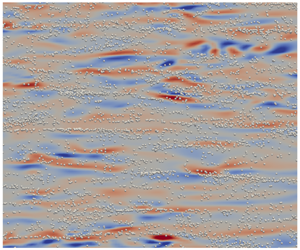Crossref Citations
This article has been cited by the following publications. This list is generated based on data provided by
Crossref.
Di Renzo, M.
Johnson, P. L.
Bassenne, M.
Villafañe, L.
and
Urzay, J.
2019.
Mitigation of turbophoresis in particle-laden turbulent channel flows by using incident electric fields.
Physical Review Fluids,
Vol. 4,
Issue. 12,
Liu, Yang
Zhang, Li
Chen, Ziyun
and
Zhou, Lixing
2020.
Numerical investigation on mixture particle dispersion characteristics in swirling particle-laden combustion chamber.
International Communications in Heat and Mass Transfer,
Vol. 117,
Issue. ,
p.
104720.
Johnson, Perry L.
2020.
Predicting the impact of particle-particle collisions on turbophoresis with a reduced number of computational particles.
International Journal of Multiphase Flow,
Vol. 124,
Issue. ,
p.
103182.
Bragg, A. D.
Richter, D. H.
and
Wang, G.
2021.
Settling strongly modifies particle concentrations in wall-bounded turbulent flows even when the settling parameter is asymptotically small.
Physical Review Fluids,
Vol. 6,
Issue. 12,
Bragg, A. D.
Richter, D. H.
and
Wang, G.
2021.
Mechanisms governing the settling velocities and spatial distributions of inertial particles in wall-bounded turbulence.
Physical Review Fluids,
Vol. 6,
Issue. 6,
Blanchard, S.
Odier, N.
Gicquel, L.
Cuenot, B.
and
Nicoud, F.
2021.
Stochastic forcing for sub-grid scale models in wall-modeled large-eddy simulation.
Physics of Fluids,
Vol. 33,
Issue. 9,
Chou, Yi-Ju
Mai, Yu-Hsuan
and
Tseng, Chien-Chou
2021.
Large-eddy simulation of coaxial powder flow for the laser direct deposition process.
Physics of Fluids,
Vol. 33,
Issue. 12,
Domino, Stefan P.
2021.
A Case Study on Pathogen Transport, Deposition, Evaporation and Transmission: Linking High-Fidelity Computational Fluid Dynamics Simulations to Probability of Infection.
International Journal of Computational Fluid Dynamics,
Vol. 35,
Issue. 9,
p.
743.
Knorps, Maria
and
Pozorski, Jacek
2021.
Stochastic modeling for subgrid-scale particle dispersion in large-eddy simulation of inhomogeneous turbulence.
Physics of Fluids,
Vol. 33,
Issue. 4,
Horwitz, J.A.K.
Iaccarino, G.
Eaton, J.K.
and
Mani, A.
2022.
The discrete Green's function paradigm for two-way coupled Euler–Lagrange simulation.
Journal of Fluid Mechanics,
Vol. 931,
Issue. ,
Motoori, Yutaro
Wong, ChiKuen
and
Goto, Susumu
2022.
Role of the hierarchy of coherent structures in the transport of heavy small particles in turbulent channel flow.
Journal of Fluid Mechanics,
Vol. 942,
Issue. ,
Chen, Pinzhuo
Chen, Sheng
Wu, Tianyi
Ruan, Xuan
and
Li, Shuiqing
2022.
Deposition velocity of inertial particles driven by wall-normal external force in turbulent channel flow.
Physical Review Fluids,
Vol. 7,
Issue. 10,
Li, Shuolin
Bragg, Andrew D.
and
Katul, Gabriel
2022.
A Co‐Spectral Budget Model Links Turbulent Eddies to Suspended Sediment Concentration in Channel Flows.
Water Resources Research,
Vol. 58,
Issue. 3,
Said, Zafar
Sundar, L. Syam
Tiwari, Arun Kumar
Ali, Hafiz Muhammad
Sheikholeslami, Mohsen
Bellos, Evangelos
and
Babar, Hamza
2022.
Recent advances on the fundamental physical phenomena behind stability, dynamic motion, thermophysical properties, heat transport, applications, and challenges of nanofluids.
Physics Reports,
Vol. 946,
Issue. ,
p.
1.
Islas, Alain
Fernández, Andrés Rodríguez
Betegón, Covadonga
Martínez-Pañeda, Emilio
and
Pandal, Adrián
2022.
Computational assessment of biomass dust explosions in the 20L sphere.
Process Safety and Environmental Protection,
Vol. 165,
Issue. ,
p.
791.
Lyu, Shiyu
and
Utyuzhnikov, Sergey
2022.
A computational slip boundary condition for near-wall turbulence modeling.
Computers & Fluids,
Vol. 246,
Issue. ,
p.
105628.
Saccone, D.
De Marchis, M.
Milici, B.
and
Marchioli, C.
2023.
Transport of inertial ellipsoidal particles in turbulent flow over rough walls.
Physical Review Fluids,
Vol. 8,
Issue. 8,
Zahtila, T.
Chan, L.
Ooi, A.
and
Philip, J.
2023.
Particle transport in a turbulent pipe flow: direct numerical simulations, phenomenological modelling and physical mechanisms.
Journal of Fluid Mechanics,
Vol. 957,
Issue. ,
Zhang, Y.
Bragg, A. D.
and
Wang, G.
2023.
Asymptotic closure model for inertial particle transport in turbulent boundary layers.
Physical Review Fluids,
Vol. 8,
Issue. 1,
Haghshenas, Armin
Hedayatpour, Shiva
and
Groll, Rodion
2023.
Prediction of particle-laden pipe flows using deep neural network models.
Physics of Fluids,
Vol. 35,
Issue. 8,


